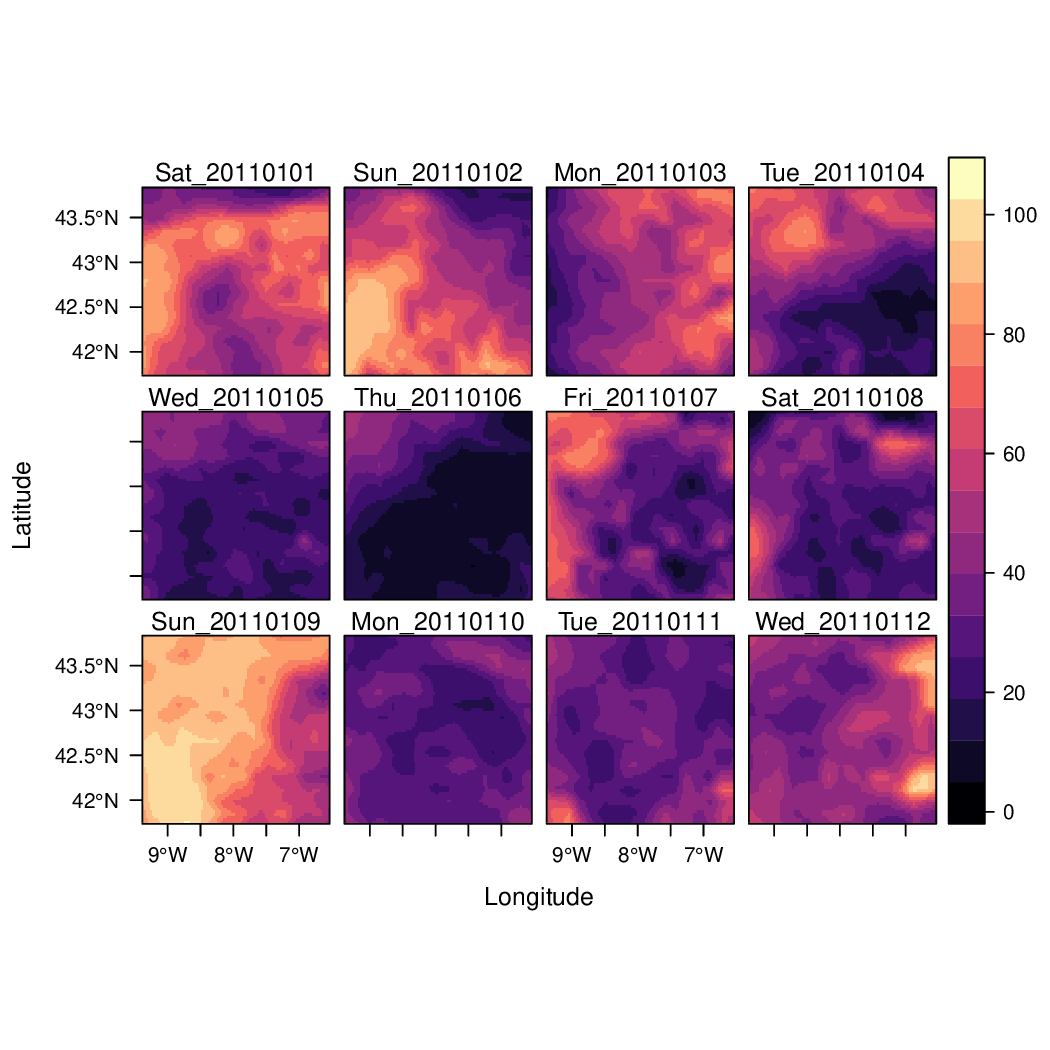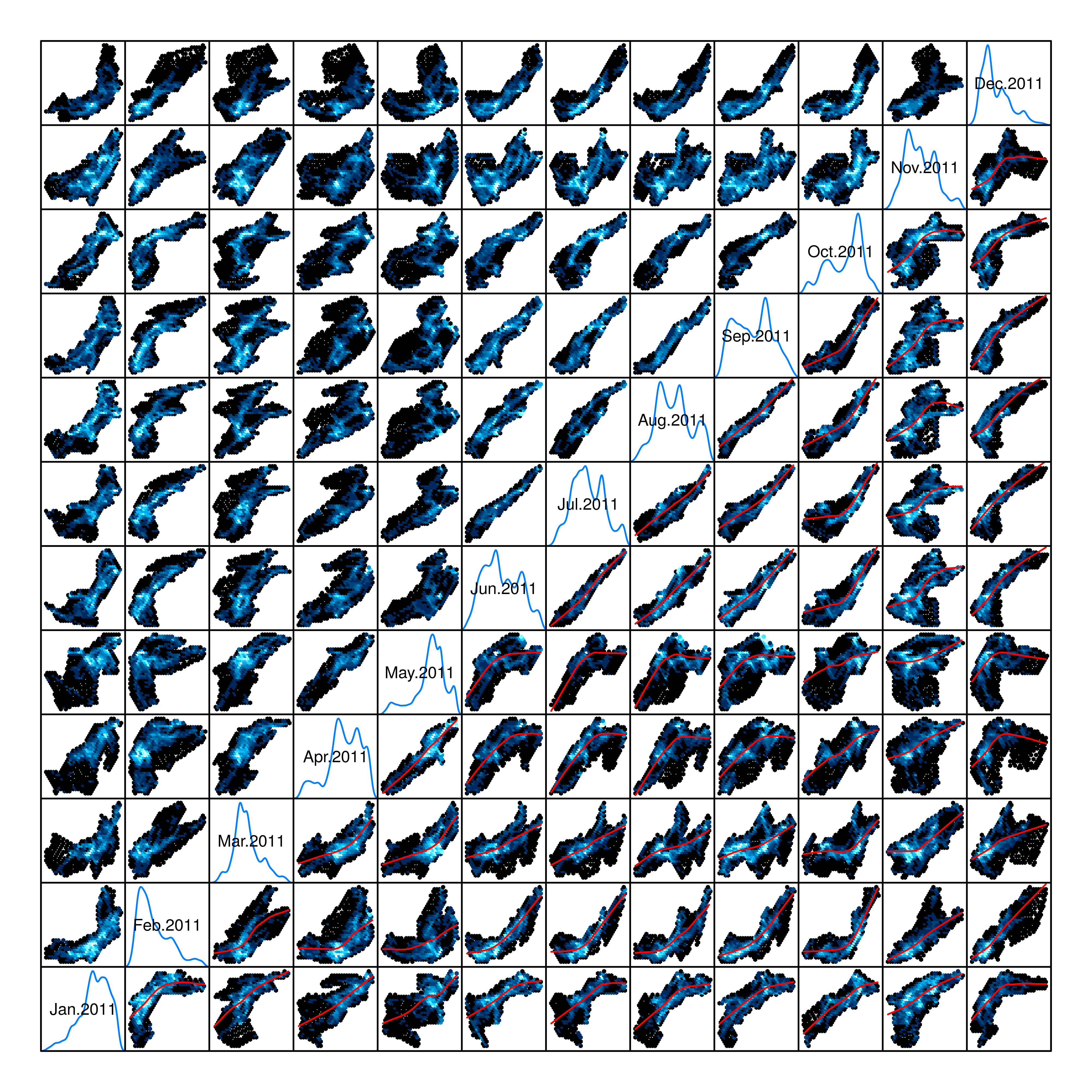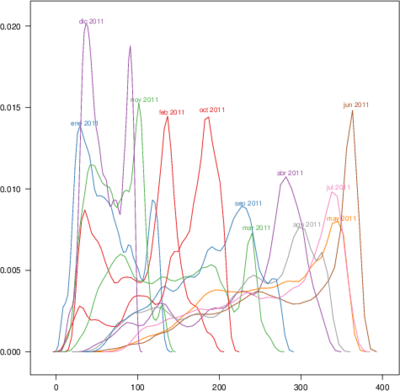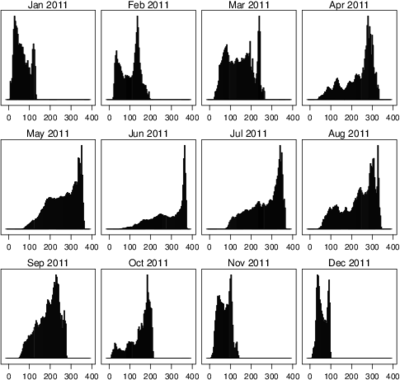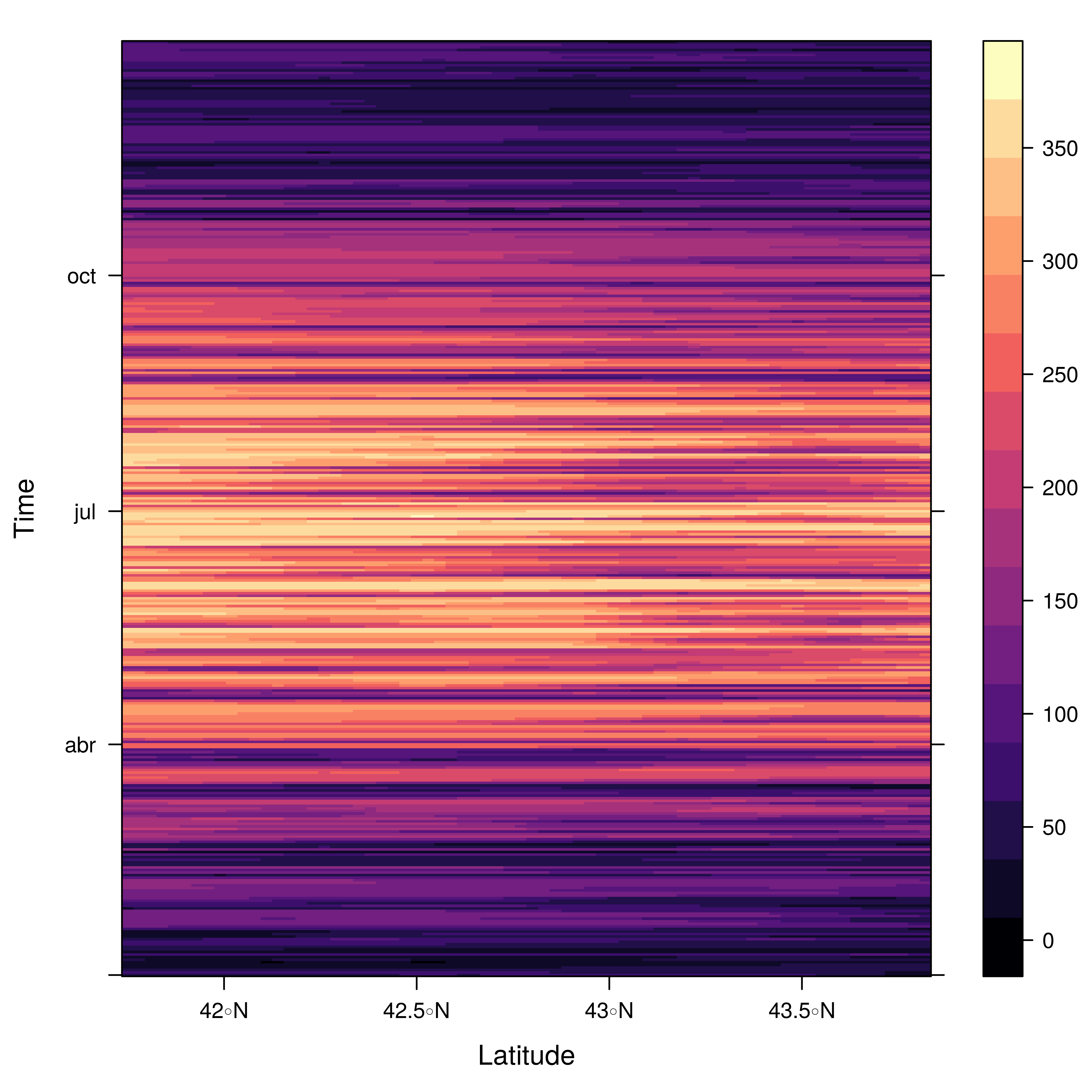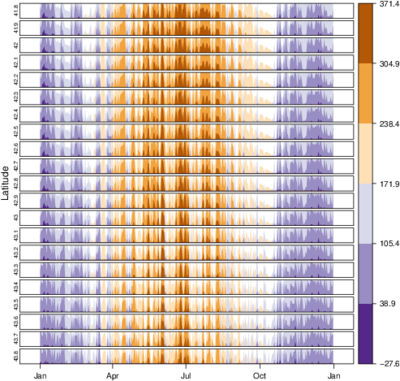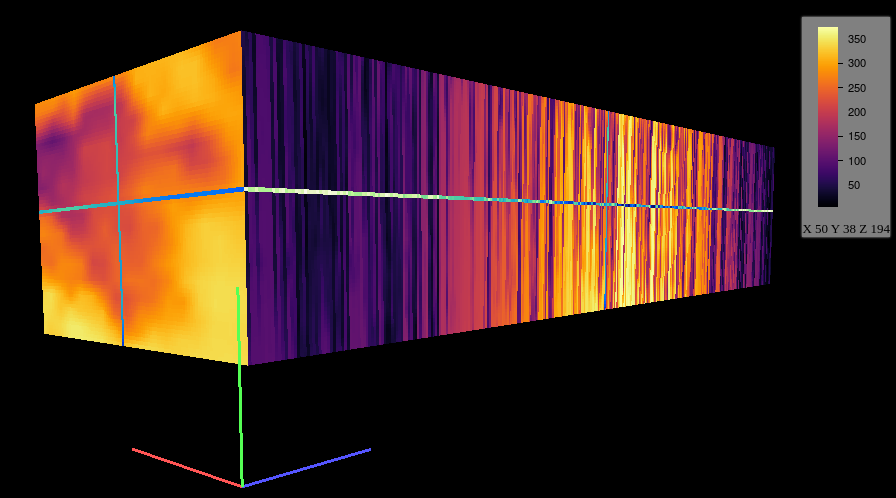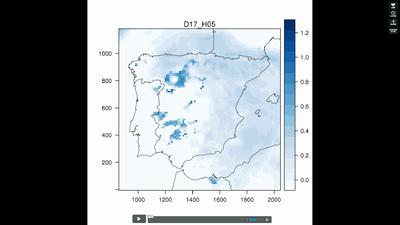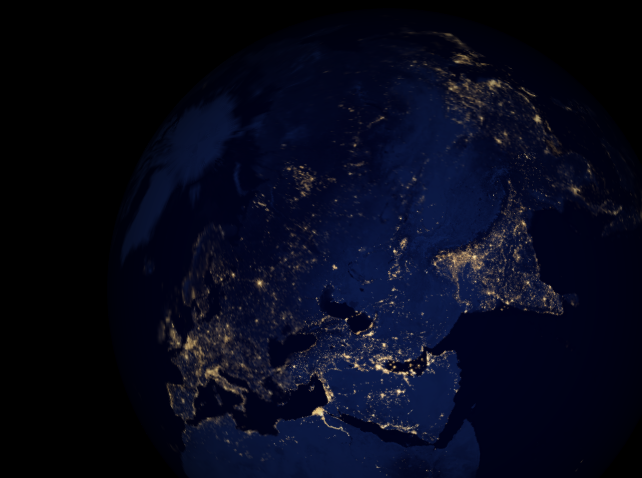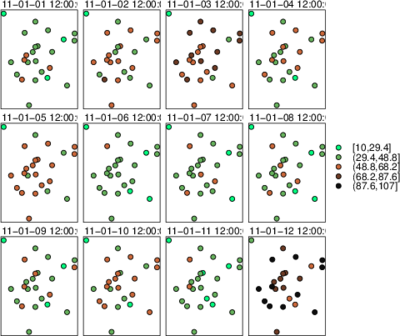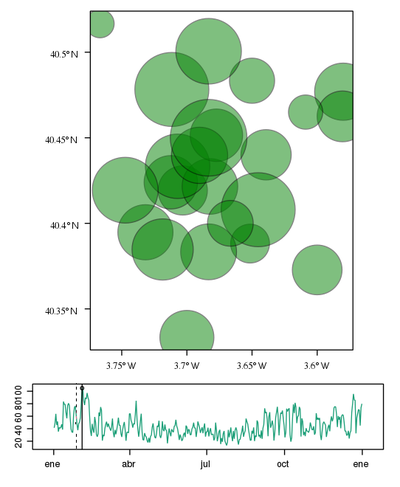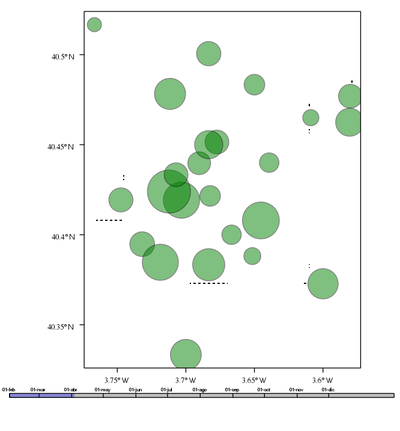Spatio-temporal data - Displaying time series, spatial and space-time data with R
Table of Contents
Raster data
Code
Raster data
################################################################## ## Initial configuration ################################################################## ## Clone or download the repository and set the working directory ## with setwd to the folder where the repository is located. Sys.setlocale("LC_TIME", 'C') ################################################################## ## CMSAF Data ################################################################## library(raster) library(zoo) library(rasterVis) SISdm <- brick('data/SISgal') timeIndex <- seq(as.Date('2011-01-01'), by = 'day', length = 365) SISdm <- setZ(SISdm, timeIndex) names(SISdm) <- format(timeIndex, '%a_%Y%m%d') ################################################################## ## Levelplot ################################################################## levelplot(SISdm, layers = 1:12, panel = panel.levelplot.raster) SISmm <- zApply(SISdm, by = as.yearmon, fun = 'mean') levelplot(SISmm, panel = panel.levelplot.raster) ################################################################## ## Exploratory graphics ################################################################## histogram(SISdm, FUN = as.yearmon) bwplot(SISdm, FUN = as.yearmon) splom(SISmm, xlab = '', plot.loess = TRUE) ################################################################## ## Space-time and time series plots ################################################################## hovmoller(SISdm) xyplot(SISdm, auto.key = list(space = 'right')) horizonplot(SISdm, digits = 1, col.regions = rev(brewer.pal(n = 6, 'PuOr')), xlab = '', ylab = 'Latitude') library(mapview) cubeView(SISdm)
Spatial point data
################################################################## ## Initial configuration ################################################################## ## Clone or download the repository and set the working directory ## with setwd to the folder where the repository is located. library(lattice) library(latticeExtra) Sys.setlocale("LC_TIME", 'C') source('configLattice.R') ################################################################## ## Data and spatial information ################################################################## library(sp) ## Spatial location of stations airStations <- read.csv2('data/airStations.csv') ## rownames are used as the ID of the Spatial object rownames(airStations) <- substring(airStations$Codigo, 7) coordinates(airStations) <- ~ long + lat proj4string(airStations) <- CRS("+proj=longlat +ellps=WGS84") ## Measurements data airQuality <- read.csv2('data/airQuality.csv') ## Only interested in NO2 NO2 <- airQuality[airQuality$codParam == 8, ] library(zoo) library(reshape2) library(spacetime) NO2$time <- as.Date(with(NO2, ISOdate(year, month, day))) NO2wide <- dcast(NO2[, c('codEst', 'dat', 'time')], time ~ codEst, value.var = "dat") NO2zoo <- zoo(NO2wide[,-1], NO2wide$time) dats <- data.frame(vals = as.vector(t(NO2zoo))) NO2st <- STFDF(sp = airStations, time = index(NO2zoo), data = dats) ################################################################## ## Graphics with spacetime ################################################################## airPal <- colorRampPalette(c('springgreen1', 'sienna3', 'gray5'))(5) stplot(NO2st[, 1:12], cuts = 5, col.regions = airPal, main = '', edge.col = 'black') stplot(NO2st, mode = 'xt', col.regions = colorRampPalette(airPal)(15), scales = list(x = list(rot = 45)), ylab = '', xlab = '', main = '') stplot(NO2st, mode = 'ts', xlab = '', lwd = 0.1, col = 'black', alpha = 0.6, auto.key = FALSE)
Animation
################################################################## ## Initial configuration ################################################################## ## Clone or download the repository and set the working directory ## with setwd to the folder where the repository is located. Sys.setlocale("LC_TIME", 'C') ################################################################## ## Data ################################################################## library(raster) library(rasterVis) cft <- brick('data/cft_20130417_0000.nc') ## set projection projLCC2d <- "+proj=lcc +lon_0=-14.1 +lat_0=34.823 +lat_1=43 +lat_2=43 +x_0=536402.3 +y_0=-18558.61 +units=km +ellps=WGS84" projection(cft) <- projLCC2d ##set time index timeIndex <- seq(as.POSIXct('2013-04-17 01:00:00', tz = 'UTC'), length = 96, by = 'hour') cft <- setZ(cft, timeIndex) names(cft) <- format(timeIndex, 'D%d_H%H') ################################################################## ## Spatial context: administrative boundaries ################################################################## library(maptools) library(rgdal) library(maps) library(mapdata) ## Project the extent of the cft raster to longitude-latitude, because ## the map package works with it. projLL <- CRS('+proj=longlat +datum=WGS84 +ellps=WGS84 +towgs84=0,0,0') cftLL <- projectExtent(cft, projLL) cftExt <- as.vector(bbox(cftLL)) ## Extract the lines from the map package using this extent boundaries <- map('worldHires', xlim = cftExt[c(1, 3)], ylim = cftExt[c(2, 4)], plot = FALSE) ## Convert the result to a SpatialLines object boundaries <- map2SpatialLines(boundaries, proj4string = projLL) ## Project to the projection of the cft object boundaries <- spTransform(boundaries, CRS(projLCC2d)) ################################################################## ## Producing frames and movie ################################################################## cloudTheme <- rasterTheme(region = brewer.pal(n = 9, 'Blues')) tmp <- tempdir() trellis.device(png, file = paste0(tmp, '/Rplot%02d.png'), res = 300, width = 1500, height = 1500) levelplot(cft, layout = c(1, 1), par.settings = cloudTheme) + layer(sp.lines(boundaries, lwd = 0.6)) dev.off() old <- setwd(tmp) ## Create a movie with ffmpeg ... system2('ffmpeg', c('-r 6', ## with 6 frames per second '-i Rplot%02d.png', ## using the previous files '-b:v 300k', ## with a bitrate of 300kbs 'output.mp4') ) file.remove(dir(pattern = 'Rplot')) file.copy('output.mp4', paste0(old, '/figs/cft.mp4'), overwrite = TRUE) setwd(old) ################################################################## ## Static image ################################################################## levelplot(cft, layers = 25:48, ## Layers to display (second day) layout = c(6, 4), ## Layout of 6 columns and 4 rows par.settings = cloudTheme, names.attr = paste0(sprintf('%02d', 1:24), 'h'), panel = panel.levelplot.raster) + layer(sp.lines(boundaries, lwd = 0.6)) library(rgl) clear3d() pal <- colorRampPalette(brewer.pal(n = 9, 'Blues')) N <- nlayers(cft) ids <- lapply(seq_len(N), FUN = function(i) plot3D(cft[[i]], maxpixels = 1e3, col = pal, adjust = FALSE, ## Disable automatic scaling of xy axes. zfac = 200)) ## Common z scale for all graphics rglwidget() %>% playwidget(start = 0, stop = N, subsetControl(1, subsets = ids)) ################################################################## ## Point space-time data ################################################################## ################################################################## ## Initial snapshot ################################################################## library(gridSVG) ## Initial parameters start <- NO2st[,1] ## values will be encoded as size of circles, ## so we need to scale them startVals <- start$vals/5000 nStations <- nrow(airStations) days <- index(NO2zoo) nDays <- length(days) ## Duration in seconds of the animation duration <- nDays*.3 library(grid) ## Auxiliary panel function to display circles panel.circlesplot <- function(x, y, cex, col = 'gray', name = 'stationsCircles', ...){ grid.circle(x, y, r = cex, gp = gpar(fill = col, alpha = 0.5), default.units = 'native', name = name) } pStart <- spplot(start, panel = panel.circlesplot, cex = startVals, scales = list(draw = TRUE), auto.key = FALSE) pStart ################################################################## ## Intermediate states to create the animation ################################################################## ## Color to distinguish between weekdays ('green') and weekend ## ('blue') isWeekend <- function(x) {format(x, '%w') %in% c(0, 6)} color <- ifelse(isWeekend(days), 'blue', 'green') colorAnim <- animValue(rep(color, each = nStations), id = rep(seq_len(nStations), nDays)) ## Intermediate sizes of the circles vals <- NO2st$vals/5000 vals[is.na(vals)] <- 0 radius <- animUnit(unit(vals, 'native'), id = rep(seq_len(nStations), nDays)) ## Animation of circles including sizes and colors grid.animate('stationsCircles', duration = duration, r = radius, fill = colorAnim, rep = TRUE) ################################################################## ## Time reference: progress bar ################################################################## ## Progress bar prettyDays <- pretty(days, 12) ## Width of the progress bar pbWidth <- .95 ## Background grid.rect(.5, 0.01, width = pbWidth, height = .01, just = c('center', 'bottom'), name = 'bgbar', gp = gpar(fill = 'gray')) ## Width of the progress bar for each day dayWidth <- pbWidth/nDays ticks <- c(0, cumsum(as.numeric(diff(prettyDays)))*dayWidth) + .025 grid.segments(ticks, .01, ticks, .02) grid.text(format(prettyDays, '%d-%b'), ticks, .03, gp = gpar(cex = .5)) ## Initial display of the progress bar grid.rect(.025, .01, width = 0, height = .01, just = c('left', 'bottom'), name = 'pbar', gp = gpar(fill = 'blue', alpha = '.3')) ## ...and its animation grid.animate('pbar', duration = duration, width = seq(0, pbWidth, length = duration), rep = TRUE) ## Pause animations when mouse is over the progress bar grid.garnish('bgbar', onmouseover = 'document.rootElement.pauseAnimations()', onmouseout = 'document.rootElement.unpauseAnimations()') grid.export('figs/NO2pb.svg') ################################################################## ## Time reference: a time series plot ################################################################## ## Time series with average value of the set of stations NO2mean <- zoo(rowMeans(NO2zoo, na.rm = TRUE), index(NO2zoo)) ## Time series plot with position highlighted pTimeSeries <- xyplot(NO2mean, xlab = '', identifier = 'timePlot') + layer({ grid.points(0, .5, size = unit(.5, 'char'), default.units = 'npc', gp = gpar(fill = 'gray'), name = 'locator') grid.segments(0, 0, 0, 1, name = 'vLine') }) print(pStart, position = c(0, .2, 1, 1), more = TRUE) print(pTimeSeries, position = c(.1, 0, .9, .25)) grid.animate('locator', x = unit(as.numeric(index(NO2zoo)), 'native'), y = unit(as.numeric(NO2mean), 'native'), duration = duration, rep = TRUE) xLine <- unit(index(NO2zoo), 'native') grid.animate('vLine', x0 = xLine, x1 = xLine, duration = duration, rep = TRUE) grid.animate('stationsCircles', duration = duration, r = radius, fill = colorAnim, rep = TRUE) ## Pause animations when mouse is over the time series plot grid.garnish('timePlot', grep = TRUE, onmouseover = 'document.rootElement.pauseAnimations()', onmouseout = 'document.rootElement.unpauseAnimations()') grid.export('figs/vLine.svg') library(rgl) library(magick) ## needed to import the texture ## Opens the OpenGL device with a black background open3d() bg3d('black') ## XYZ coordinates of a sphere lat <- seq(-90, 90, len = 100) * pi/180 long <- seq(-180, 180, len = 100) * pi/180 r <- 6378.1 # radius of Earth in km x <- outer(long, lat, FUN = function(x, y) r * cos(y) * cos(x)) y <- outer(long, lat, FUN = function(x, y) r * cos(y) * sin(x)) z <- outer(long, lat, FUN = function(x, y) r * sin(y)) ## Read, scale, and convert the image nightLightsJPG <- image_read("https://eoimages.gsfc.nasa.gov/images/imagerecords/79000/79765/dnb_land_ocean_ice.2012.13500x6750.jpg") nightLightsJPG <- image_scale(nightLightsJPG, "8192") ## surface3d reads files up to 8192x8192 nightLights <- image_write(nightLightsJPG, tempfile(), format = 'png') ## Only the png format is supported ## Display the sphere with the image superimposed surface3d(-x, -z, y, texture = nightLights, specular = "black", col = 'white') writeWebGL('nightLights', width = 1000) cities <- rbind(c('Madrid', 'Spain'), c('Tokyo', 'Japan'), c('Sidney', 'Australia'), c('Sao Paulo', 'Brazil'), c('New York', 'USA')) cities <- as.data.frame(cities) names(cities) <- c("city", "country") library(XML) geocode <- function(x){ city <- x[1] country <- x[2] urlOSM <- paste0('http://nominatim.openstreetmap.org/search?', 'city=', city, '&country=', country, '&format=xml') ## Parse the webpage xmlOSM <- xmlParse(urlOSM) ## Use only the first result cityOSM <- getNodeSet(xmlOSM, '//place')[[1]] ## Extract attributes: longitude... lon <- xmlGetAttr(cityOSM, 'lon') ## and latitude lat <- xmlGetAttr(cityOSM, 'lat') ## Return them as a vector as.numeric(c(lon, lat)) } points <- apply(cities, 1, geocode) points <- t(points) colnames(points) <- c("lon", "lat") cities <- cbind(cities, points) library(geosphere) ## When arriving or departing include a progressive zoom with 100 ## frames zoomIn <- seq(.3, .1, length = 100) zoomOut <- seq(.1, .3, length = 100) ## First point of the route route <- data.frame(lon = cities[1, "lon"], lat = points[1, "lat"], zoom = zoomIn, name = cities[1, "city"], action = 'arrive') ## This loop visits each location included in the 'points' set ## generating the route. for (i in 1:(nrow(cities) - 1)) { p1 <- cities[i,] p2 <- cities[i + 1,] ## Initial location departure <- data.frame(lon = p1$lon, lat = p1$lat, zoom = zoomOut, name = p1$city, action = 'depart') ## Travel between two points: Compute 100 points between the ## initial and the final locations. routePart <- gcIntermediate(p1[, c("lon", "lat")], p2[, c("lon", "lat")], n = 100) routePart <- data.frame(routePart) routePart$zoom <- 0.3 routePart$name <- '' routePart$action <- 'travel' ## Final location arrival <- data.frame(lon = p2$lon, lat = p2$lat, zoom = zoomIn, name = p2$city, action = 'arrive') ## Complete route: initial, intermediate, and final locations. routePart <- rbind(departure, routePart, arrival) route <- rbind(route, routePart) } ## Close the travel route <- rbind(route, data.frame(lon = cities[i + 1, "lon"], lat = cities[i + 1, "lat"], zoom = zoomOut, name = cities[i+1, "city"], action = 'depart')) summary(route) ## Function to move the viewpoint in the RGL scene according to the ## information included in the route (position and zoom). travel <- function(tt){ point <- route[tt,] rgl.viewpoint(theta = -90 + point$lon, phi = point$lat, zoom = point$zoom) } ## Examples of usage of travel ## First frame travel(1) rgl.snapshot('images/travel1.png') ## Frame no.1200 travel(1200) rgl.snapshot('images/travel2.png') movie3d(travel, duration = nrow(route), startTime = 1, fps = 1, type = 'mp4', clean = FALSE)
